
It seems like the older dogs get, the less active they become. Is it because –
- They are in pain and can’t move about like they used to
- As dogs age they naturally become less energetic
- Weight gain has made it uncomfortable or too difficult to move
- Failing eyesight makes Spot less confident going out, so he doesn’t
- Some pup parents believe an old dog doesn’t need more than one short walk per day…if that
- The dog seems to prefer lying in bed to going out
The belief that an old dog doesn’t need or want to go out leads to quite the vicious cycle.
They don’t get taken out = they’re bored and depressed = they lie on their bed all day because they’re bored and depressed = proof they were right an old dog doesn’t need/want to go out.
All dogs need exercise
Let’s work with that blanket statement that every dog needs exercise. The question then becomes what type and how much.
While there are plenty of senior dogs who can still run and jump with the stamina of a dog half their age, plenty more can’t and don’t. For that reason it’s important to understand limitations, and create an exercise routine 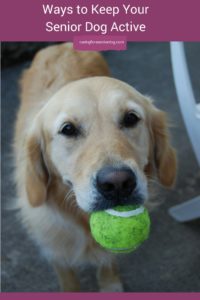 suited to your dog’s needs and abilities.
suited to your dog’s needs and abilities.
Rather than taking your dog for just one long walk a day, which may be too much for him to handle, consider breaking it up into 2, 3 or even 4 shorter ones. Getting out only once a day means an awful lot of hours your dog is lying around doing nothing. Not only is it boring, that lack of movement can cause stiffness both of which can be minimised/prevented with shorter more frequent walks.
What I do for my dog Red
Red is about 16 ½ years old, blind with quite a few health issues, but she still needs to get out and about. She goes out for short walks four times a day, in addition to her pee breaks. It’s easier for her, won’t cause lameness and it breaks up her day.
The consequences of inactivity
If your dog doesn’t move he won’t want to move, and some of the consequences of that inactivity include –
- Weight gain/obesity
- Joint pain
- Heart disease
- Diabetes
The same consequences we suffer by the way!!
The benefits of a more active lifestyle
Not only will the consequences mentioned above be less likely to occur (although of course it’s impossible to say they never will), there are other added benefits –
- The opportunity for your dog to socialise and make new friends
- Avoid depression and boredom
- Mental stimulation which not only helps expend excess energy, but could stave off canine cognitive dysfunction (doggie dementia)
- Improves and maintains muscle tone
- Keeps your dog at a healthy weight
- Improves your dog’s quality of life
Wow, look at all those benefits! It’s important to realise they apply to dogs of all ages so get your pup moving!!
Conditions that may limit mobility
This all sounds well and good, but what if your dog is suffering from a condition that makes it too painful to move? Then your priority is to get your dog out of pain. I know that sounds obvious, but you might be surprised to know how many people I have spoken to who believe it is simply a natural part of aging. They don’t realise how much pain their dog is in, or the number of treatment options available.
Common conditions that may cause mobility issues include –
- Arthritis
- Hip dysplasia
- Injury
- Decreased heart function/heart disease
- Obesity
This article entitled “How to Treat Arthritis Pain in Dogs Naturally” has lots of treatment options you might find helpful for your dog.
Have a chat with your vet
If you’ll be increasing your dog’s exercise or introducing new ones, please check with your vet first. He may be able to advise you on the best types as well as recommended length and frequency. If it’s been awhile since your 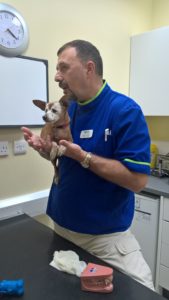 dog has had a check-up, now may be a good time to book that appointment. You’ll want to make sure he’s healthy with no injuries to stand in the way.
dog has had a check-up, now may be a good time to book that appointment. You’ll want to make sure he’s healthy with no injuries to stand in the way.
If your dog has had an injury or other issue that has limited the amount of exercise he has been able to do, a rehab vet may be needed to help you design a program tailored to your dog’s needs.
If your dog will be exercising more it stands to reason he will be burning more calories. Speak to your vet about the need for an increase in amount or type of food to ensure he doesn’t start losing weight…unless he has to!
You may also want to ask about post-exercise care in case your dog experiences some soreness, due to an increase in activity level. He may recommend a pain medication or if you prefer a natural approach massage, hydrotherapy or stretching exercises can help.
Keep it interesting
There are lots of ways to keep your dog active, and many dogs will appreciate some variety.
- Visit the dog park
- Go for a swim
- Teach him new tricks/brush up on old ones
- Have play dates
Before you get started
Let’s talk about some things that can impact your dog’s comfort, and how to keep him safe.
Temperature
Older dogs can have a harder time regulating their body temperature, and may not tolerate or enjoy the climates they used to. On a hot day aim for outings earlier in the morning and later in the evening, although some places  are steaming all hours of the day and night. Be aware of the possibility of dehydration, and know that increased panting can put a strain on his heart. Give your dog water when out and keep things short and sweet.
are steaming all hours of the day and night. Be aware of the possibility of dehydration, and know that increased panting can put a strain on his heart. Give your dog water when out and keep things short and sweet.
On cold days a sweater and even a coat will make your dog more comfortable. Plenty of dogs handle the snow, but some need booties or wax for protection.
Red is from Florida and used to love sitting in the backyard in the sun. As she got older she was unable to tolerate the heat as well and would pant quite a bit. On the flip side she never enjoyed the cold, so now that we’re in England she wears a sweater most of the year, and a coat when it’s really cold. One year I took her to Toronto in the winter and she was less than impressed. A quick pee and poop were all she could manage, and paw wax needed to be applied before each outing, as she wouldn’t let me near her with booties! Not a fun time for either of us I’m afraid.
Don’t be a “weekend warrior”
Life can be hectic and our dogs don’t always get out as much as we would like, so many people try and make up for it on the weekend. It’s almost like they put their dogs through a week’s worth of exercise in one session. Please don’t!! It’s too much in one go and certainly of no benefit to your dog.
If you aren’t home during the week perhaps a friend, neighbour or family member can take your dog out. What about hiring a dog walker? Bringing lunch from home just once or twice a week can easily pay for a couple of days help.
Terrain
It’s important to be aware of the types of surfaces you’ll be exercising your dog on, and any potential hazards.
Hills or inclines may be too difficult for dogs with joint problems or mobility issues.
Think traction – slick floors (like in stores for example) or uneven surfaces can be tough to walk on, especially if your dog is not as steady on his feet as he used to be.
Watch out for holes.
Avoid hot pavement.
Some dogs have trouble walking on snow and ice so be prepared with boots or paw wax.
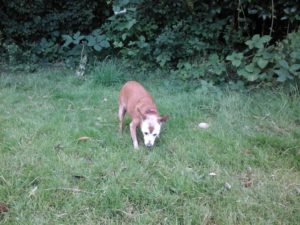 Rocky terrain can be a challenge so take it slow at first. If your dog is not handling it well find a more even surface.
Rocky terrain can be a challenge so take it slow at first. If your dog is not handling it well find a more even surface.
Red weighs only about 9lbs, has tiny little legs and is blind so I’m very conscious of where we walk. She doesn’t like pebbled surfaces, is okay on pavement but prefers grass. The thing is grass can be very uneven and have all kinds of dips and holes so I have to be vigilant when we’re out.
Breathing
Keep an eye, or ear I should say, on your dog’s breathing. Some panting is normal but if he seems to be panting quite a bit, coughing, or showing any signs of distress stop exercising immediately.
Watch the clock
Decide on how long you’ll be out for and stick to it. Even though he’s doing well and wants to keep going, it’s best to go home or end the play session before he starts limping or showing other signs of over exertion.
Stay out of the sun
When possible walk on the shady side of the street, and stick to shaded areas when playing.
Keep him hydrated
Have plenty of fresh water available to prevent dehydration.
Follow his cues
You may be pressed for time and want the walk over and done with as quickly as possible. Hey we’re all guilty of that!! It’s important to remember that as much as some of us tend to use this as our exercise time as well, it’s all about the dog so follow his cues.
What do I mean?
- Don’t push him to do more than he can or wants to do
- If he starts to slow down, turn around or look back towards home, take him home
- If there is a certain time of day he prefers to walk then take him out at that time of day
- If he wants to stop what feels like every two seconds and take a break or sniff a leaf, let him
- Your dog may want to slow down or stop but you’re doing the power walking thing, so he does as well. Take it easy and walk at his pace
Keep to a familiar route…or not
What the heck does that mean? Failing eyesight and hearing can make a dog anxious in new surroundings, and dogs suffering from dementia can get easily confused and scared. Sticking to familiar areas makes for a more 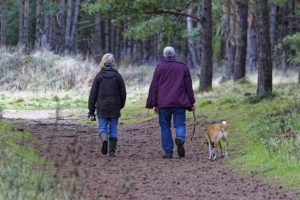 relaxed and happy dog, and a more enjoyable outing for everyone.
relaxed and happy dog, and a more enjoyable outing for everyone.
On the flip side, seeking out new routes for your daily walks can keep your dog alert, entertained and stimulated.
Whether you go with the first option of sticking to the familiar, or the second of seeking out some adventure will depend on your dog. You know him and are the best judge of which option will suit him. Not sure? Stay in the area but go down a different street, then see how your dog responds. If he’s loving the new surroundings great, if he seems confused or uncomfortable go back to what he knows.
Adapt to your dog’s changing abilities
The plan you have your dog on now may not be suitable in a year, or even six months from now. He may be getting stronger because of the exercise or frailer as he ages, so re-assess his routine from time to time and adapt when necessary.
Keeping your senior dog active
It’s encouraging how many ways there are to keep an old dog active, both indoors and out.
The daily walk
Walking is the greatest form of exercise for dogs (and humans), so get out and take a walk…or several. It’s a lot more beneficial for your dog to take a few shorter, slower walks throughout the day than one long one.
Swimming
Swimming is a great choice for older dogs, and how fun to let him paddle in a nearby lake or pool.
Why is it so great?
- Low impact
- Supports your dog’s weight so there is no stress, strain or impact on joints
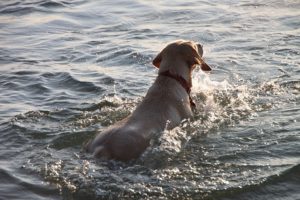 Good for cardiovascular health
Good for cardiovascular health- Keeps him at a healthy weight
- Access to an indoor pool means your pup can swim year round
Outdoor swimming should be limited to very warm weather, and your dog dried off quickly to avoid a chill.
For some dogs it’s an easier form of exercise than walking but be careful not to let him overdo it.
Supervise him at all times in case he gets into trouble and needs help.
If your dog doesn’t want to get in the water don’t force him, no matter how beneficial you believe it to be. Perhaps you should bring your bathing suit and jump in, that may be all the motivation he needs!
How easy is it for him to get in and out of the pool? A ramp with a gradual incline may help.
Running
Yes we’ve talked a lot about taking it nice and easy and here I am suggesting running!! I realise the word brings to mind dogs flying across the field chasing a ball or other four legged friend. Well that’s the image I get, but running can also be done at a very slow and easy pace, and may be perfectly suitable for your dog.
Start off very gently, keep checking for signs of fatigue or excess panting, and stick very close to home. If your dog seems to want to stop frequently, is slowing down or keeps looking back towards home stop, switch to a slow walk and get him home.
Don’t let him reach the point where he’s tired or panting, end your run before that happens.
Fetch and Frisbee
If your dog has always enjoyed a good game of fetch or Frisbee, it doesn’t have to end just because he’s gotten older it just needs to be modified. Instead of throwing the ball or Frisbee as high or as far as you used to, keep it 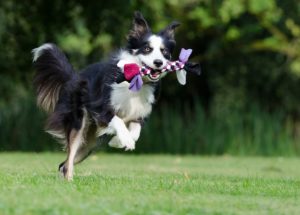 low to the ground and close. He can still go after it, just at a slower pace.
low to the ground and close. He can still go after it, just at a slower pace.
If that’s too much, gently roll the ball along the ground making sure your dog doesn’t have to go too far to retrieve it.
Walk around the house
If, for whatever reason, you can’t take your dog out often enough how about some walks around the house or garden? You’ll keep him moving and help prevent stiffness.
Training
I’m sure you’ve heard by now – old dogs can absolutely learn new tricks and it will help keep his mind sharp.
Treat dispensing toys
Puzzle toys that hide food are a great way to challenge your dog mentally, which also helps get rid of pent up energy. Varying levels of difficulty provide your dogs with a challenge. You can even feed him part of his meal in the toy and turn meal time into an activity.
Hide and seek and hide the treat
These two are great ways to keep your dog engaged and active no matter his physical condition, and similar to what you’re trying to accomplish with the treat dispensing toy.
For hide and seek all you need is a tasty treat your dog doesn’t get too often, let him see where you’re going then tell him to “go find it!” Hide the treat can be done in several ways, two of which I describe here.
Take 3 cups light enough for your dog to knock over, place a treat under one of them and tell him to find it. Another variation is to take a muffin tin, put a treat in a few of the sections, then cover each with something like a tennis ball and have him find it.
These are all great games to play in addition to his physical exercise, but definitely important on days he doesn’t get out much.
Therapy/range of motion exercises
Hydrotherapy, massage, stretching and strengthening can all make your dog feel so much better by loosening joints and making it easier for him to get around.
I came across this article by Dr. Karen Becker called “Anti-Aging Exercises to Keep Your Senior Pet Active.” There is a lot of great information as well as exercises you can do with your dog at home. https://healthypets.mercola.com/sites/healthypets/archive/2012/01/26/anti-aging-exercises-for-pets.aspx
A canine physiotherapist can help design an exercise program specifically for your dog, and they can probably show you how to perform them at home. Do a search for professionals in your area.
How much exercise is too much?
There is no one size fits all answer because each dog is different. Determining how much is too much for your dog will depend on many factors including his weight, health conditions, physical limitations…
There are ways to tell if your dog has done too much –
- Limping
- Weakness
- Stiffness
- Excessive panting
- Excessive drooling
- Slowing down/wanting to stop
- Reluctant to keep walking/swimming or playing
- Coughing
Mobility aids
If your senior dog has difficulty with even the shortest walk, or mobility issues prevent him from getting any exercise, you’ll be comforted to know there are several products that can help ensure every dog, no matter his ability, can enjoy some much needed physical exercise and mental stimulation.
The pet stroller
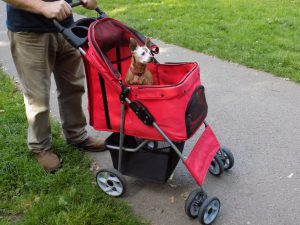 My all-time favourite is the pet stroller, and to say it has helped us so much is a definite understatement. Take it with you on your walk and when he’s had enough let him hop a ride. Going on a family day out? Perfect, he never has to get left behind again.
My all-time favourite is the pet stroller, and to say it has helped us so much is a definite understatement. Take it with you on your walk and when he’s had enough let him hop a ride. Going on a family day out? Perfect, he never has to get left behind again.
Boots/socks
Sliding on slick flooring is a common concern and can easily lead to injury. Non slip booties and socks are a tremendous help, but if your dogs are like mine and you can’t get them on for love or money, rugs or non-slip mats work just as well.
Slings and harnesses
Another incredible aid we have used is a sling. Perfect for dogs who are suffering from weakness or recovering from spinal surgery (as in our dog’s case), the sling or harness helps support your dog by taking some of the weight off his joints. He can now enjoy going for a walk again.
Dog wheelchair
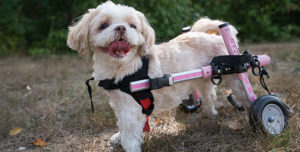 A doggy wheelchair can give your dog back his freedom, and significantly improve his quality of life. Whether your dog has arthritis, hip dysplasia, a slipped disc, neurological issues or any other condition that makes walking a challenge, a wheelchair can help. For more information and types of wheels available, visit handicappedpets.com.
A doggy wheelchair can give your dog back his freedom, and significantly improve his quality of life. Whether your dog has arthritis, hip dysplasia, a slipped disc, neurological issues or any other condition that makes walking a challenge, a wheelchair can help. For more information and types of wheels available, visit handicappedpets.com.
Drag bags
If your dog has disabled back legs, the drag bag allows him to move around while protecting his limbs and chest from scraping against the floor and causing sores. For more information visit handicappedpets.com.
Ways to keep your senior dog active – conclusion
Just because your dog is older doesn’t mean he prefers to spend his days lying on his bed…even though it may seem that way. Dogs of all ages and abilities need to get out and about, and that means your senior dog as well. Not only is it essential for his health and wellbeing, it’s a great bonding opportunity for both of you.
How do you keep your senior dog active? Share your tips in the comment section below.
Get your FREE report – Tell Tail Signs Your Dog May Have Dementia
I would like to invite you to join Senior Dog Care Club, my Facebook group for parents of senior dogs. There you will find lots of helpful tips and advice, a place to ask questions and share experiences. I look forward to welcoming you.

 How to Naturally Improve Mobility in Senior Dogs
How to Naturally Improve Mobility in Senior Dogs
I love that you took the time to be VERY thorough with this post. Senior pets deserve the very best and it is important to take those extra steps.
Thanks! I do try and be as thorough as I can. I want readers to go away feeling like I’ve helped, not wondering why so little was written.
Since my dog is now technically a senior dog, this I find this post very relevant. She doesn’t know she’s a senior dog yet – she thinks she’s still a puppy – however the grey on her snout betrays her true age. I worry about when her age will finally catch up to her.
Don’t tell her!! No reason to think she won’t stay in her puppy phase for many more years to come!
I’ve been thinking about getting Mr. N socks as we switched to hard floors and he slips a little bit. Is there a brand you recommend?
Hardwood floors can get very slippery, so if you don’t want to cover them up with area rugs booties are a great option. A couple that have been highly recommended are a brand called Grippers. Apparently they can be a bit fiddly to get on but the person who recommends them say they are a lot longer lasting than others she’s tried. A company called Dog Quality also has been recommended for their quality products. Of course what works for one dog won’t necessary work as well for another, so sometimes it’s a case of trial and error.
There is a lady here that does amazing work — with a salt pool — the salt is high enough that pets with injuries or age “float” more just like in the red sea! I love the idea…. my little dude will turn 8 this year – less than half way… I can’t even think about it but … maybe I should and be better prepared in 10 or so years. 🙂
That’s so interesting, I’ve never heard of it before. I love the Dead Dea so if it’s anything like that it would be a fun experience!!
Great post and Layla will be 11 this year and I am monitoring her more although my vet who saw her two weeks ago said WOW she looks and acts like a puppy. Layla loves her morning walks so we do one long one in the mornings and then the rest of the day shorter ones. I also make sure she goes to the park once a day to watch the people go by, she does not play there, maybe wander around but otherwise sits on the bench watching and I have always said that is good for her mental stimulation and that is what is important.
I now have an amazing backpack for her – will be writing more about it on my blog and she loves it so when I do take her with me to do errands I keep it on my back so she can hop into it, watch the world go by and not walk that much. A stroller is just too hard for me when using public transport.
Wow she’s 11! She doesn’t look anywhere near her age, I wish I could say that!! People watching is such a fun activity for all of us. I’d be interested to hear about your backpack. I have a stroller for Red which we couldn’t live without, but a backpack sounds like it would fill the gap when a stroller is just too awkward.
This is a very comprehensive article that every senior dog owner should know. I will definitely share on my business page!
Thanks Heather, I appreciate that!!
Wow! 16.5 years old, I hope that our two live to that grand age. This is a great post, really thorough and I learnt a lot, many of these tips aren’t just for senior dogs. Our two are still young, 5 and 3 this year, so I have no experience of senior dogs, as yet.
Thanks Michelle I’m so glad you found it helpful. It’s so true these tips are perfect for pets of all ages.
Inactivity is the beginning of the end. It actually makes pain worse too. Jasmine always had zest for her hikes regardless of her age, even regardless of her health challenges with exceptions of the times when she literally could not walk. It is absolutely important to keep a senior dog active. Which might take medical help at least at first.
I agree, once the activity stops it causes all sorts of problems, and yes it can make pain worse. You’re right that at the beginning some medical intervention may definitely be needed, but as the level of activity increases often medication can be decreased or paired with alternative therapies these dogs can often be more active than they have been in years.
This is such great information Hindy! Now that we’ve moved back to New York the weather doesn’t cooperate the way it did in Phoenix so there are a lot of days I don’t take my little one, Phoebe outside. She thoroughly enjoys playing fetch & tug with her stuffies indoors though so I make sure she gets a good workout that way. Sharing.
Love & Biscuits,
Dogs Luv Us and We Luv Them
That is a big weather change Cathy, hope Phoebe is adjusting. We live in a cold climate as well so it’s a wardrobe of sweaters and coats for us!! Glad she enjoys playing inside as well.
These are solid ideas for keeping a senior pet in good physical health. I groaned when I saw your term “weekend warrior” because I couldn’t agree more. When my cat got diabetes years ago, our vet commented on how managing diabetes in a senior cat is actually easier because cat activity levels are pretty static. Dogs, on the other hand, may have owners who pull the weekend warrior bit throwing off all of their insulin levels.
It’s an interesting point about cat activity levels remaining pretty constant! I know it’s tough with people at work all day and too many dogs not getting much exercise, but trying to make up for it on the weekend really is just an injury waiting to happen.
I just requested to join your Senior Dog Care Club! Great tips here…my Siberian Huskies are now seniors: three are 10 and one will be 13 in March. With my late Husky, who had hind end weakness issues as a side effect to epilepsy meds, I did use the a sling and harness as part of his exercise and therapy. Great tools! I so agree with your suggestion of adapting to our dogs’ abilities as they do change. While I surely miss the days of when all of my Huskies would run free on the larger side of my yard, (sigh, where does the time go?!), I know today they can no longer do that (three have had CCL surgeries/tears/conservative care) as arthritis has started to set in. I’m Pinning this as well! Excellent post!
Happy to welcome you to the group Dorothy. Thanks for pinning the post, I hope others benefit from some of the recommendations.
Terrific advice for dogs of all ages, especially senior dogs. I love that you include alternatives to the daily walk such as learning tricks and swimming. The low impact nature of swimming makes it the perfect choice for exercise, however, mental stimulation is just as important. Great post!
Thank you Stephanie. I know there are too many dogs who don’t get walked because they may be in some pain, so they’re kept in the house. Hopefully senior pup parents will realise there are other ways to keep their dogs active and engaged. Of course with the right pain relief their dogs can be out walking and enjoying the fresh air.